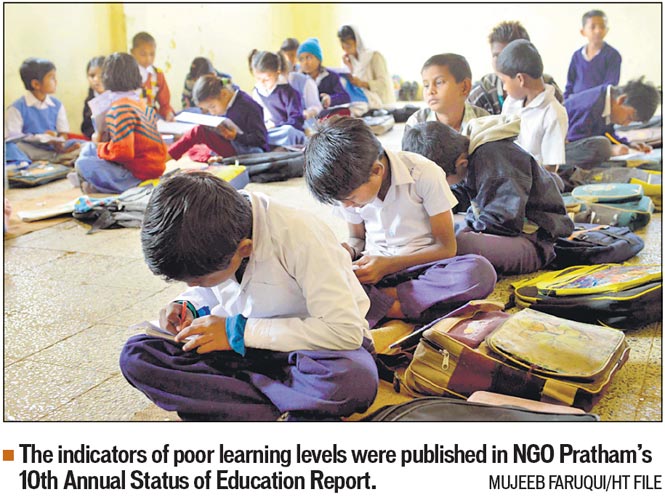New Delhi : Dspite various government initiatives and near-universal enrolment in the age group 6-14, basic learning achievements in reading and maths remain low and dismal, according to the tenth Annual Status of Education Report (ASER).
ASER 2014, released Tuesday, has found that the proportion of children enrolled in private schools has gone up as compared to last year, and that there has been an improvement in school facilities and compliance with the Right to Education Act.
According to the survey, basic reading levels remain “disheartening” with only a fourth of all Class III children able to read Class II text fluently, and under half in Class V able to do so. In fact, 25 per cent of Class VIII children could not read Class II level text. The improvement in reading levels in the last few years has, at best, been marginal. In 2014, 48.1 per cent of Class V children could read Class II level text, up from 47 per cent in 2013 and 46.8 per cent in 2012. Again, 40.2 per cent children in Class II were found able to read Class I text, after 38.7 per cent in 2012.
While reading levels remained largely unchanged in most states, some such as Bihar, Assam, Jharkhand, Chhattisgarh, Madhya Pradesh and Maharashtra show a decline in the last five or six years.
The all-India rural figures for basic arithmetic have remained largely unchanged on most parameters over the last few years. In 2014, only 25.3 per cent of Class III children could do two-digit subtraction, down from 26.3 per cent in 2012. For Class V children, the ability to divide has increased slightly. The percentage of children in Class II who cannot recognise numbers up to 9 has increased, from 11.3 in 2009 to 19.5.
The ability to read English has remained largely unchanged in lower primary grades (25 per cent of Class V students could read simple English sentences in 2014 — unchanged since 2009), but has seen a visible decline in upper primary grades (from 60.2 per cent in Class VIII in 2009 to 46.8 per cent in 2014). Roughly 60 per cent of those who could read words could explain the meaning of those words.
A key finding of the survey is that even as enrolment levels for the age group 6-14 are 96 per cent or higher, the figure is not as encouraging for the 15-16 years age group, with 15.9 per cent boys and 17.3 per cent girls in these ages currently out of school. The RTE Act covers the 6-14 group.
Meanwhile, a greater proportion of parents has started reposing faith in private schools. According to the report, the proportion of 6- to 14-year-olds in rural India enrolled in private schools has gone up from continued…
…………………………..
One in five Class 2 kids don’t know their numbers, Gujarat scores low
One in every five or nearly 20% Class 2 students cannot identify numbers up to 9 while half the students in Class 5 cannot read a text prescribed for Class 2. The worrying indicators of poor learning levels in the country were published in NGO Pratham’s 10th Annual Status of Education Report (ASER) in Delhi on Thursday.
According to the report, mathematical ability in general has declined across the country, with Karnataka and Andhra Pradesh being the only exceptions. The numbers this year have gone up since 2009 when 11.3% students were unable to recognize numbers, the report, which covers both government and private schools, added.
While 51.9% students in class 5 lacked fluency in reading simple text, the numbers showed a slight improvement over the figures in 2012 (53.2%) and 2013 (53%). “In 2014, in class 3, only a fourth of all children can read a class 2 text fluently. This number rises to just under half in class 5. Even in class 8, close to 75% children can read class 2 level text,” the report said.
The ability to read English showed a decline. Just 46.8% of class 8 students could read simple sentences in English in 2014, a decline from 60% in 2009. The percentage of lower primary grade students who could read English remained 25%. The data casts a shadow on the near universal enrollment in ages 6 to 14 for the sixth year in a row.
In state-wise observations, the report said nearly 12% girls between ages 11 and 14 in Rajasthan were not enrolled while the proportion was 9.2% for Uttar Pradesh. Pointing out to student absenteeism, the report said nearly 72% students enrolled in primary schools and 71.1% in upper primary schools were present on the day of the visit.
Student-teacher ratios, however, are improving, the report added. “The percentage of schools complying with RTE-mandated pupil-teacher ratios has increased from 45.3% in 2013 to 49.3% in 2014. In 2010, this figure was 38.9%.”
Gujarat scores low in English, Maths
According to a supplement of the report, Gujarat and Maharashtra lag far behind the national average in terms of English and Maths learning. Just 9.7% of class 5 students in Gujarat and Maharashtra could read sentences in English with Maharashtra sailing in the same boat, the Trends over Time report 2014 said.
The percentage of class 3 children in Gujarat who could do subtraction and class 5 students who could do division was at least 10 percentage points below the national average. Maharashtra fell behind by 7–8 percentage points.


